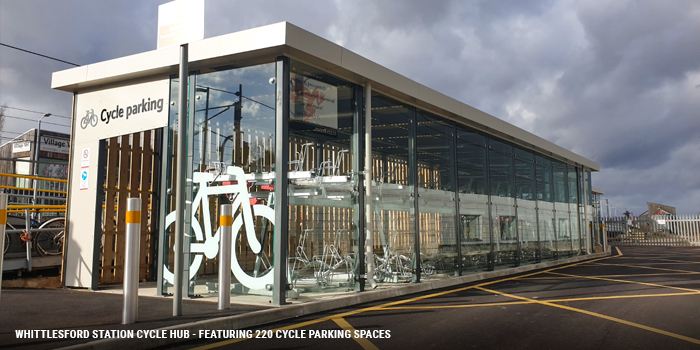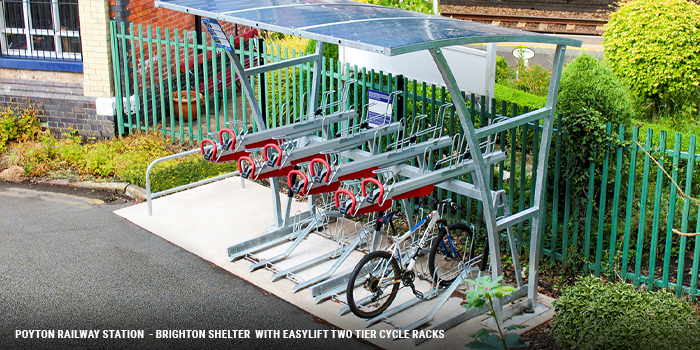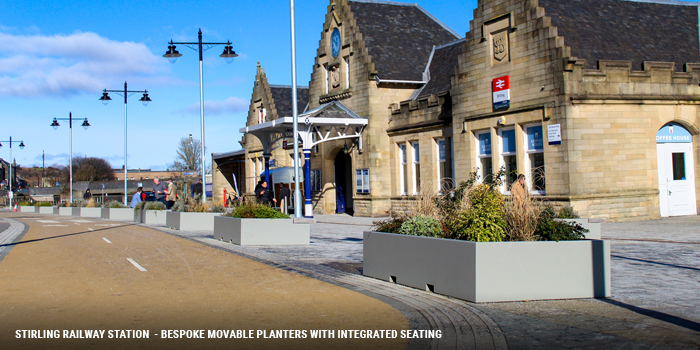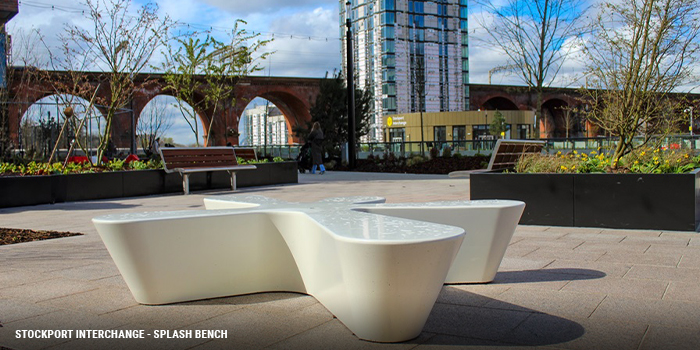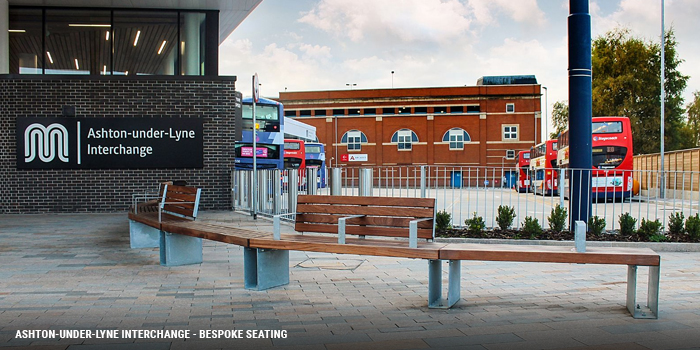
Creating accessible attractive and cycle-friendly transport hubs
Posted on 18th July 2024
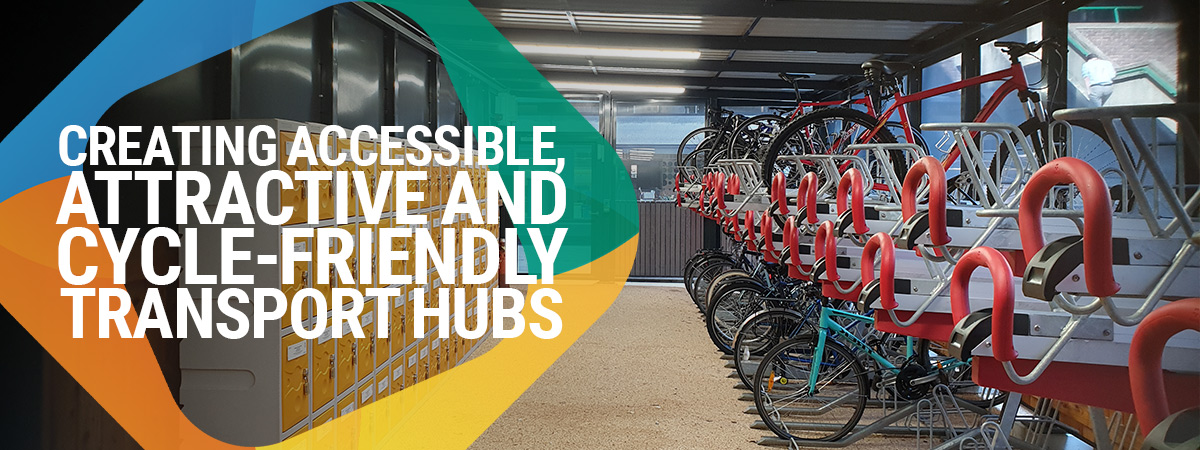
The quality and visual appeal of transport hubs and interchanges, including railway stations, bus stations and tram stops, is crucially important in encouraging greater use and maximising customer satisfaction. Both are key to facilitating increased use of public transport across the country, but especially in major urban areas, where switching more people away from cars can help to improve local environmental conditions by lowering levels of road congestion, noise and air pollution.
Investing time and resources in the planning of outdoor public spaces around transport hubs not only helps to drive user engagement with the facility as a means of getting from A to B, but it can also enhance the neighbourhood and be a catalyst for further local development. A carefully considered masterplan is one that integrates attractive green spaces, seating, shelters, cycle parking facilities and much more into the public realm, with safety, security and accessibility always at the forefront of specification decisions.
The range of street furniture and cycle parking options available from Bailey Street Furniture Group (BSFG) means the design possibilities are virtually unlimited. Its products and systems cater for all kinds of transport environments from listed Victorian railway station buildings and post-war modernist style stations, to airports, multi-modal interchanges, ferry terminals and simple stand-alone tram and bus stops.
Improving sustainability by
encouraging cycling
It is widely acknowledged that more emphasis on the end-to-end journey is critical for creating the shift towards sustainable transport and achieving net zero by 2050. Hence why, in future, more journeys must combine cycling and walking with a train journey – free from car transport to the station.
However, one estimate suggests that currently as few as 2% of rail users cycle to and park their bikes at British railway stations prior to travel. Increasing this will only be possible by ensuring that transport interchanges of all kinds – not just railway stations – offer secure parking and shelter where possible.
It is here where BSFG company Cyclepods works with developers, train operating companies and local authorities to provide solutions. The company offers an extensive range of secure cycle storage facilities encompassing everything from comprehensive cycle hubs and its award-winning ‘pods’ to cycle stands, shelters and repair stands.
In one Cyclepods project at Whittlesford Parkway railway station in Cambridgeshire, it provided a cycle hub with 220 cycle parking spaces split between a secure access-controlled area for 88 spaces and an open area for 132 with a repair station and pump. The company also increased the number of spaces with new racks, complete with its Brighton Shelter to provide cover.
This shelter, combined with Easylift Premium Two Tier Racks, was also chosen to provide a cycle parking facility in another Cyclepods project at Poynton railway station in Cheshire. This also featured its cargo bike parking solution and police-approved Streetpods.
Further projects, including a motorcycle parking facility at Couldson South station, and multiple cycle hubs provided for stations across the South West Trains network further demonstrate Cyclepods capabilities.
Boosting biodiversity
Another sustainability benefit achievable through a well-conceived public realm is in terms of biodiversity, and giving transport hub users the opportunity to connect more with nature as they pass through. One of the ways this can be achieved in locations where there is limited space to create gardens and planting beds, or strict planning restrictions apply, is to use planters, which can be specified to incorporate seating too.
An excellent example of how this can work is a project completed at Stirling railway station where movable planters were provided by Bailey Streetscene. A series of bespoke oval planters complete with curved seating, plus matching rectangular steel planters were commissioned featuring channels to the base so they can be moved with a forklift and repositioned where required.
Two large cone planters were also provided to house small trees, offered a striking visual element while minimising disruption to the surface beneath. This project showcases how incorporating greenery into the urban landscape improves the overall aesthetic appeal of a station’s gateway, enhancing it while promoting environmental sustainability.
Creating safe, accessible
and sheltered spaces
One of the reasons why some people are discouraged from using public transport is because they don’t feel safe when using facilities. So, it is extremely important to ensure mistakes of previous generations, particularly in respect of poorly designed or ill-equipped stations, are avoided today. In the longer term, positive design choices will help to win the confidence of those who have had a bad experience, and challenge negative perceptions.
Good design in this respect requires careful consideration of the spatial arrangement supplemented by active monitoring, such as through CCTV, as well as plenty of lighting. Shelters, canopies and walkways are crucial too. They can be utilised not only as protection from the elements, but also to clearly define entrances and waiting area, and also incorporate integrated lighting.
Accessibility must also be maximised so less able-bodied people can use train, bus and tram networks without barriers. A number of design considerations will need to be addressed in regard to the site layout and levels, but provision of seating is also a key factor here. Most of us will spend some time waiting around at transport hubs so seating provides welcome convenience, but for elderly people or those with limited mobility, it can be essential.
There are numerous seating options available from BSFG companies Bailey Streetscene and Artform Urban to meet the aesthetic goals of a transport hub project, whatever that may be.
Balancing functionality with
superb aesthetics
Given their vulnerability to vandalism, misuse and exposure to harsh weather conditions, it is unsurprising that some transport hubs have been designed and built with durability in mind. That can make them appear bleak and uninviting, giving the appearance of being a building that you simply pass through with little appreciation of their form.
This need not be the case as the mighty railway stations of the Victorian era show us. Today, good design is not only about interior spaces and the platforms to board and alight trains, trams or buses, but the spaces outside too. Two projects completed in north west England by BSFG illustrate this.
In Stockport town centre, Artform Urban and Bailey Streetscene worked with the team creating the new Stockport Interchange and Merseyway Shopping Centre.
Artform Urban worked alongside the project architects to develop a range of furniture that would be design-led, functional and considered the demanding design brief from the end client Stockport Council. The Splash bench was chosen along with Tree Line modular concrete seating to add the finishing touches to a recently completed bus interchange to create a state-of-the-art facility that improves public transport for the town and surrounding areas.
And in Ashton-under-Lyne, Bailey Streetscene was tasked with providing an extensive seating package for a new transport interchange. It provided bespoke DDA-compliant seating for the users that would maximise accessibility by incorporating armrests and backrests for less able people.
Seating extending over 48 metres was provided to a strict colour palette, manufactured using durable materials to meet a low maintenance brief. This combined galvanised steelwork with hardwood timber, and the design featured open leg supports that allowed for efficient cleaning and no areas for rubbish build-up.
Investing in well-designed, accessible, and aesthetically pleasing transport hubs not only enhances user satisfaction and encourages public transport use but also contributes to environmental sustainability, local development, and improved safety, ultimately making these spaces more welcoming and effective for diverse communities.
Find out more about BSFG’s solutions at www.bsfg.co.uk
